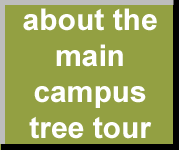 |  |  |  |
An individual instance of Asimina triloba (pawpaw)

Permanent unique identifier for this particular organism:
http://bioimages.vanderbilt.edu/vanderbilt/1-166
Notes:
This small, shrubby tree is sandwiched between two diverging paths on the north side of Furman Hall.
Pawpaw is a distinctive tree in many ways. It has unlobed leaves without teeth along the margin which are notable because of their large size and typical shape: widening toward the tip end. The terminal buds are long and an unusual rusty brown color. The bark is gray and unridged, but has a rough surface.
Pawpaw flowers appear in the early spring and are typical of "carrion" flowers that are pollinated by confused carrion flies: they smell bad and have a purple color. Frequently they do not set fruit, apparently because they don't get enough pollen from other trees. Fruit growers have found that they can reliably get fruit if they hang dead fish or road kill in their pawpaw patch to increase the number of pollinators. However, careful studies of pawpaw pollinators call into question whether the flowers actually attract specific pollinators. It may be that the swarms of flies incidentally pollinate the flowers when they land on the exposed stamens rather than being duped into thinking that the flowers are dead flesh.
Pawpaw is a distinctive tree in many ways. It has unlobed leaves without teeth along the margin which are notable because of their large size and typical shape: widening toward the tip end. The terminal buds are long and an unusual rusty brown color. The bark is gray and unridged, but has a rough surface.
Pawpaw flowers appear in the early spring and are typical of "carrion" flowers that are pollinated by confused carrion flies: they smell bad and have a purple color. Frequently they do not set fruit, apparently because they don't get enough pollen from other trees. Fruit growers have found that they can reliably get fruit if they hang dead fish or road kill in their pawpaw patch to increase the number of pollinators. However, careful studies of pawpaw pollinators call into question whether the flowers actually attract specific pollinators. It may be that the swarms of flies incidentally pollinate the flowers when they land on the exposed stamens rather than being duped into thinking that the flowers are dead flesh.
 |  |
Load database and switch to thumbnail view
Use this stable URL to link to this page:
http://bioimages.vanderbilt.edu/vanderbilt/1-166.htm
This organism is a living specimen that is part of the Vanderbilt University Arboretum with the local identifier 2-946.
This particular organism is believed to have managedmeans of establishment.
This organismal entity has the scope: multicellular organism.
Identifications:
Asimina triloba
(L.) Dunal
sec. fna.org 1993
common name: pawpaw
family: Annonaceae
Identified 2002-05-07 by Steven J. Baskauf
Location:
Vanderbilt University, Nashville, Davidson County, Tennessee, US
Click on these geocoordinates to load a map showing the location: 36.14817°, -86.80176°
Coordinate uncertainty about: 10 m.
Location of individual determined from GIS database.
Occurrences were recorded for this particular organism on the following dates:
2002-05-07
2002-09-09
2003-10-03
2006-03-06
2006-04-07
2006-04-14
2006-05-09
2006-08-08
2014-09-11
The following images document this particular organism.
Click on a thumbnail to view the image and its metadata.Load database and enable navigation by taxon and organism.


















